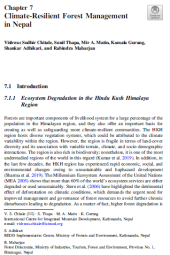Climate-Resilient Forest Management in Nepal
Summary
Forests play a crucial role in the livelihoods of a significant Himalayan population and contribute to creating resilient communities in the region. The Himalayan region exhibits diverse vegetation systems influenced by its climate variability. Despite its rich biodiversity, the Himalayas remain one of the least studied regions globally. Over the past few decades, the Himalayan region has undergone rapid economic, social, and environmental changes, primarily due to unsustainable development practices. The Millennium Ecosystem Assessment indicates that more than 60% of the world's ecosystem services face degradation or unsustainable use. Deforestation, particularly in the lower and middle slopes due to anthropogenic activities, has led to increased forest degradation. Urgent and improved forest resource management and governance are essential to prevent further chronic disturbances and degradation. The impacts of climate change, including increased drought and heat stress, alterations in phenology, rising pest and fire incidents, and changing nutrient dynamics, are adversely affecting forest composition, productivity, and ecosystem services. These changes also impact forest-based livelihoods, with observed shifts and declines in vegetation productivity in the Himalayan region due to climate change.
Categories:
Article
Link Source:
https://link.springer.com/chapter/10.1007/978-3-030-73569-2_7
Publisher:
Russian Journal of Plant Physiology
Published Year:
2021
